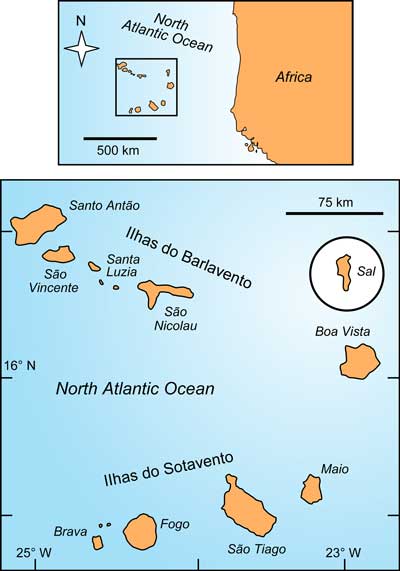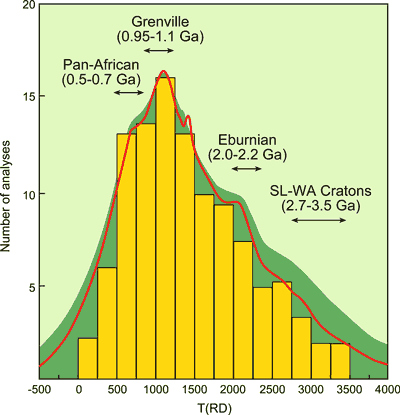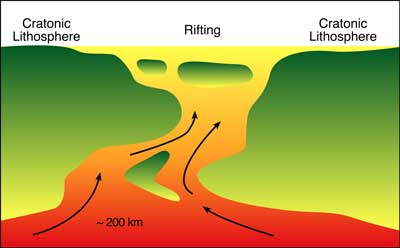 |
Ancient
continental lithospheric mantle beneath oceanic
islands – Cape Verde Archipelago |
Suzanne
O’Reillya,
Massimo
Coltortib,
Costanza Bonadimanb, William
Griffina &
Norman
Pearsona
aGEMOC National Key Centre, Department of Earth and
Planetary Sciences, Macquare University, NSW 2109,
Australia
sue.oreilly@mq.edu.au, bill.griffin@mq.edu.au, norman.pearson@mq.edu.au
bDip.
Scienze della Terra, Università di
Ferrara, Via Saragat, 1, 44100 Ferrara, Italy
clt@unife.it; bdc@unife.it
This webpage is a summary of: Coltorti,
M., Bonadiman, C., O’Reilly, S.Y., Griffin,
W.L. and Pearson, N.J. Buoyant ancient continental
mantle embedded in oceanic lithosphere (Sal Island,
Cape Verde Archipelago), Lithos, 120,
223-233, 2010.
The Cape Verde Islands lie in the
Atlantic ocean off West Africa (Figure 1), in a clearly
oceanic setting. The lavas of some islands carry mantle-derived
xenoliths of depleted peridotites (low in Ca, Al, Fe
and other basaltic components), petrologically similar
to those derived from cratonic lithospheric mantle.
Oceanic lithospheric mantle, in contrast, consists
mainly of less-depleted peridotites (lherzolites and
harzburgites) formed by the extraction of mid-ocean
ridge basalts. In
situ Re-Os analyses of individual sulfide grains
from depleted xenoliths from the island of Sal yield
Re-depletion model ages ranging mainly from Neoproterozoic
to Archean. Their age distribution mirrors the tectonic
history of the western margin of the West African Craton
and the corresponding continental margin of Brazil.
These data suggest that part of the Cape Verde Archipelago
is underlain by a fragment of ancient subcontinental
lithospheric mantle (SCLM), left stranded in the oceanic
lithosphere during the opening of the Atlantic Ocean
(Coltorti
et al.,
2010). Contamination of
magmas by this ancient continental root can explain
the unusual isotopic characteristics of some Cape Verde
lavas without recourse to recycled continental material
in the sources of mantle plumes (O’Reilly
& Griffin, 2010).

Figure 1. Locality map for the
Cape Verde Islands relative to Africa, and for the
position of Sal within the Cape Verde Island group.
The sulfide Re-Os age data from the
Cape Verde mantle xenoliths (Figure 2) broadly reflect
the timing of events characterizing the tectonic history
of the Atlantic suture, and especially of the West
African margin. The oldest Archean ages correlate with
the ancient rocks of the West African Craton; the peak
around 2 Ga correlates with the Birrimian volcanism
and the Eburnian orogeny along the margins of the craton.
The major Neoproterozoic peak (ca 1 Ga) matches the
collision of the West African and Sao Luis Cratons
and related volcanism. The youngest group of ages (550-800
Ma) corresponds to the breakup of the continent along
the earlier suture, and the opening of the Iapetus
Ocean. The dominance of Neoproterozoic ages is consistent
with the position of the Cape Verde Archipelago closer
to the inferred former suture between Africa and South
America, where pre-existing SCLM would have been most
strongly modified.

Figure 2. Age histogram (n=135)
and cumulative probability plot of TRD (rhenium depletion)
age (n=108) for mantle sulfides.
The broad spread of model ages between ca 1800-1300
Ma (ca 30% of the data) may reflect either reactions
between successive sulfide generations (i.e. mixed
ages), or episodic metasomatism of the SCLM. In any
case, the existence of possible “mixed ages” requires
the presence of an older (cratonic) component. This
possibility is also suggested by recent global tomographic
mapping which shows a high-velocity region below the
Cape Verde Archipelago (Figure 3).

Figure 3. Seismic tomography (Vs)
image of northern Africa and the adjacent Atlantic
Ocean at 0-100 km (for description of the methodology
and sources, see O’Reilly et al., 2009 and
Begg et al., 2010) showing high-velocity regions
in the ocean basin. (Note colour reversal with hot
colours indicating high velocity).
The presence of a domain of Archean-Proterozoic SCLM
beneath the Cape Verde Islands suggests that the opening
of the ocean basin did not involve a clean break, with
generation of new oceanic lithosphere directly overlying
the underlying convective mantle. Depleted Archean
to Proterozoic SCLM is buoyant relative to the convecting
mantle (e.g., Poudjom Djomani et al.,
2001; O’Reilly et al., 2001; Griffin
et al., 2009), and detached fragments are thus
unlikely to sink. Instead they may “surf the
convecting mantle” (Alard et al., 2005)
as the ocean opens. Such fragments of relict SCLM may
be widespread in the ocean basins.
We suggest that during rifting, before true oceanic
crust has been formed, rising MOR-like melts impregnated
the pre-existing SCLM, causing a progressive heating
and rheological weakening. A combination of rifting
and ductile extension could produce an intermingling
of old pieces of SCLM and new oceanic lithosphere.
Geological and geochemical studies of the Lanzo peridotite
massif (Piccardo et al., 2007; Rampone
et al., 1998) provide a possible analogue. Lanzo
may represent a transition between old SCLM and oceanic
lithosphere. Extending SCLM was modified by magmas,
causing progressive thermo-chemical erosion of the
SCLM.
The presence of an SCLM remnant beneath the Cape Verde
islands also can explain the complex isotopic signatures
of the magmatic rocks. Geochemical signatures typical
of ancient SCLM components have been recognised in
some lavas on Sal (e.g., Holm et al.,
2006) and the interaction of rising magmas (derived
from the convecting mantle) with the SCLM could impart
these signatures.
If such SCLM remnants are widespread in the ocean
basins, they offer an alternative interpretation of
the origin of EM1 and EM2 components (geochemical signatures
in basalts interpreted as evidence of recycled crust)
in ocean-island basalts. Rather than reflecting continental
components subducted into the lower mantle and sequestered
until tapped by rising plumes, these signatures may
simply indicate contamination of rising magmas by relatively
shallow SCLM remnants (O’Reilly
et al.,
2009).
The new Re-Os data resulting from this study, coupled
with those from abyssal peridotites, suggest that the
traditional picture of oceanic lithosphere as the residues
of basalt extraction at mid-ocean ridges is probably
an oversimplification. Instead, the development of
ocean basins may involve disruption of continental
lithosphere and incorporation of relict SCLM domains
in oceanic regions (Figure 4). The repeated opening
and closing of oceans, commonly along older sutures,
must have left many SCLM remnants of different ages
within the ocean basins. This process will produce
significant compositional and geochronological heterogeneity
in the oceanic lithosphere over time.

Figure 4. Cartoon showing possible
oceanic rifting mechanism with listric faulting at
cratonic margins and stranding of ancient subcontinental
lithospheric mantle remnants in the ocean basin (after
O’Reilly
et al., 2009).
References
-
Alard, O., Luguet, A., Pearson,
N.J., Griffin, W.L., Lorand, J.-P., Gannoun, A.,
Burton, K.W. and O’Reilly,
S.Y. 2005. In situ Os isotopes in abyssal
peridotites bridge the isotopic gap between MORBs and
their source mantle. Nature, 436,
1005-1008.
-
Begg, G.C., Griffin, W.L., Natapov,
L.M., O’Reilly,
S.Y., Grand, S.P., O’Neill, C.J., Hronsky,
J.M.A., Poudjom Djomani, Y., Swain, C.J., Deen,
T. and Bowden, P. 2009. The Lithospheric architecture
of Africa: Seismic tomography, mantle petrology
and tectonic evolution. Geosphere, 5,
23-50.
-
Coltorti,
M., Bonadiman, C., O’Reilly, S.Y.,
Griffin, W.L. and Pearson, N.J. 2010. Buoyant ancient
continental mantle embedded in oceanic lithosphere
(Sal Island, Cape Verde Archipelago). Lithos, 120,
1-2, 223-233.  doi:10.1016/j.lithos.2009.11.005 doi:10.1016/j.lithos.2009.11.005
-
-
Holm, P.M., Wilson, J.R. , Christensen,
B.P., Hansen, L., Hansen, S. L., Hein, K.M., Mortensen,
A.K., Pedersen, R., Plesner, S. and Runge, M.K.
2006. Sampling the Cape Verde Mantle Plume: Evolution
of Melt Compositions on Santo Antaõ, Cape
Verde Islands. Journal
of Petrology, 47, 145-189.
-
O’Reilly, S.Y., Griffin,
W.L., Poudjom Djomani, Y.H. and Morgan, P. 2001.
Are Lithospheres Forever? Tracking changes in sub-continental
lithospheric mantle through time. GSA Today, 11,
4-10.
-
O’Reilly, S.Y., Zhang, M., Griffin, W.L., Begg,
G. and Hronsky, J. 2009. Ultradeep continental roots
and their oceanic remnants: a solution to the geochemical "mantle
reservoir" problem? Lithos, 112,
S2, 1043-1054.
-
-
Piccardo, G.B., Zanetti, A.
and Müntener,
O. 2007. Melt/peridotite interaction in the Southern
Lanzo peridotite: Field, textural and geochemical
evidence: Melting, metasomatism and metamorphic
evolution in the lithospheric mantle. Lithos Special Issue, 94,
181-209.
-
Poudjom Djomani, Y.H., O’Reilly,
S.Y., Griffin, W.L. and Morgan, P. 2001. The density
structure of subcontinental lithosphere through
time. Earth
and Planetary Science Letters, 184,
605-621.
-
Rampone, E., Hofmann, A.W. and Raczek, I. 1998.
Isotopic contrasts within the Internal Liguride ophiolite
(N. Italy): the lack of a genetic mantle-crust link. Earth
and Planetary Science Letters, 163,
175-189.
-
last updated 26th
November, 2010 |
